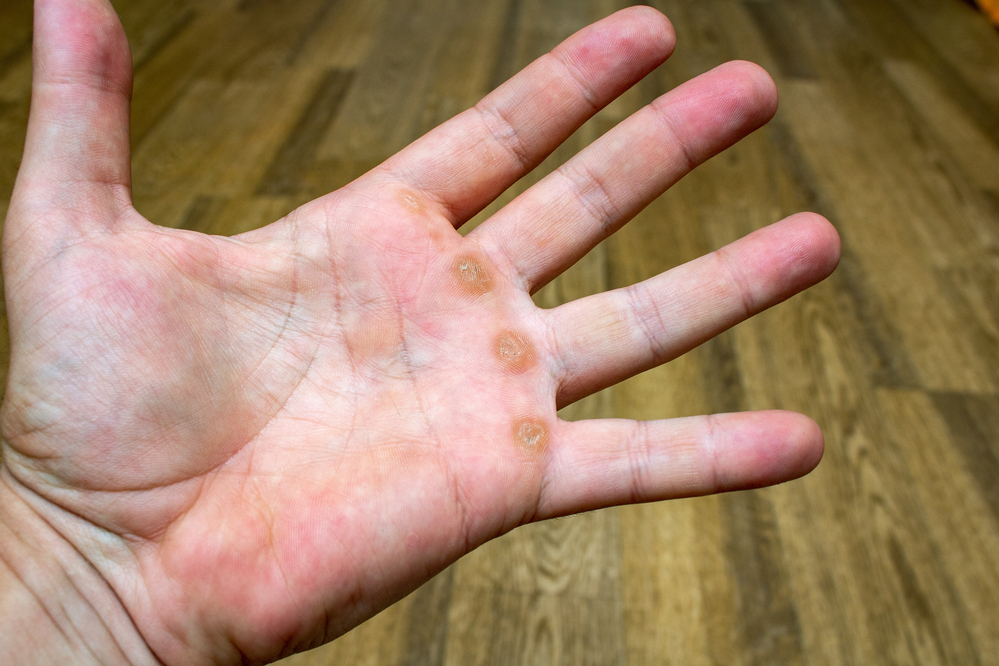You want your kettlebell workouts to show on your body, not on your hands.
Rough, unsightly, and sometimes painful calluses are a natural response to repeated wear and tear to your hands and fingers.
You’re trying to improve your body, and your body is trying to protect itself, so it’s important to remember that you’re on the same team!
There are strategies you can take to avoid calluses entirely! Let’s go through a few easy steps that will leave you happier, healthier, and callus-free.

1. Don’t grip too hard
While kettlebell workouts help train the finger tendons and hand muscle, the core of your workout isn’t testing your hand strength.
A beginner mistake is believing that a slick kettlebell handle is better.
This is due to beginners improperly gripping during rotations, gripping too hard when it isn’t necessary.
Use the best form possible to activate your target muscle areas while gripping the kettlebells firmly but not tightly.
The harder you grip on a bare kettlebell, the more unnecessary friction is created between your skin and the kettlebell which triggers more calluses to form.
Take the time to re-adjust your grip when necessary rather than powering through and potentially causing damage to your skin!
2. Take off any hand jewellery
This is easy to forget, but rings will chafe and pinch against your skin as you move.
It may not be painful, but the micro abrasions build up over time and trigger the growth of a thick layer of skin.
Besides preventing calluses, it’s always a good idea to remove jewellery before a workout!
As with working on a car or anything with moving parts, wearing jewellery during a workout is never ideal. Place your rings and bracelets in a secure place where they won’t get lost or cause injury.
A simple finger injury or hand swelling is immediately compounded when there’s a ring cutting off the circulation.
In extreme cases, a ring can be caught in equipment or crevices, causing the metal to cut into the wearer’s skin, resulting in degloving of the digit.
(Softer metals can also be bent and dinged during workouts, so it’s better all around that it’s left out of the workout altogether.)
3. Use chalk
Chalk works to keep your hands dry and your grip firm as you lift by increasing the friction between your hands and kettlebells.
This may sound backwards (since calluses are caused by improper amounts of friction), but while sweaty hands decrease friction, their moisture also leaves your skin vulnerable to tears. Sweat can make the kettlebell handles slick – chalk helps to prevent that. Not just a light dusting, either – use a lot of chalk.
This will guarantee that there are enough layers to last through your sets.
While this will make the handles feel “rougher”, if you’re not gripping the handles too tightly (see tip #1) then you will not cause more abrasions by using a proper amount of chalk.
4. Wear protective gym gloves
Proper equipment is key to any endeavor! A pair of well-fitting gym gloves will go a long way towards preserving your hands and preventing the buildup of calluses.
Heat and moisture cause humidity, which is a leading factor in skin tears.
Thin wristbands are another great addition to your kettlebell equipment, as they will prevent sweat from trickling down onto your hands and into your gloves.
The ugly truth is that while calluses build up over time, they often start as painful blisters.
Moist, warm, skin is more likely to separate under rough treatment, so keeping your hands dry is one of the most important factors for reducing calluses.
Remember that gloves also do all of the following:
- Absorb moisture
- Decrease friction between hands and kettlebells
- Lessen the need for chalk
- Create a germ barrier between you and other gym-goers
- Increase pressure relief from heavier weights
A great pair of gym gloves should definitely be part of your workout routine!
5. Don’t lift too heavy
Like with any form of exercise, it’s best to start with a lower weight and work your way up.
Trying to lift a too-heavy kettlebell makes it impossible for you to lift correctly; the kettlebell handle will slip in your grip, you will fatigue faster, and you could injure yourself – all without actually getting a quality workout in! Pain is not the name of the game!
The more a kettlebell slips in your hands, the more you exponentially increase the probability of severe blisters, with absolutely no benefit.
Your kettlebell training is preparing you to increase your grip strength, pull strength, your endurance, and flexibility – don’t put yourself out of commission because your hands are injured due to lifting too heavy!
6. Drink plenty of water
There are no downsides to remaining properly hydrated at all times. Your skin is the largest organ you have, and it needs water just as much as your liver and kidneys do.
By drinking enough fluids, your skin gains the elasticity it needs to withstand abrasions that come from working with your hands.
There are plenty of strategies to ensure that you’re getting the proper hydration you need. Simple steps like getting a water filter or flavored water to improve palatability, setting reminders, getting a reusable water bottle – all the way up the tech ladder to setting reminders or installing an app!
Your skin, hands, and muscles will thank you. Consider the lack of calluses a hefty bonus.
That’s all for this article, but how many kettlebells do you need?
Hope this helped!
Sources
I’ve been in the fitness and strength training industry for nearly a decade. In that time, I’ve gained 30 pounds of muscle, written hundreds of articles, and reviewed dozens of fitness supplements. As for my educational background, I’m a currently studying for my Active IQ Level 3 Diploma in Personal Training.

